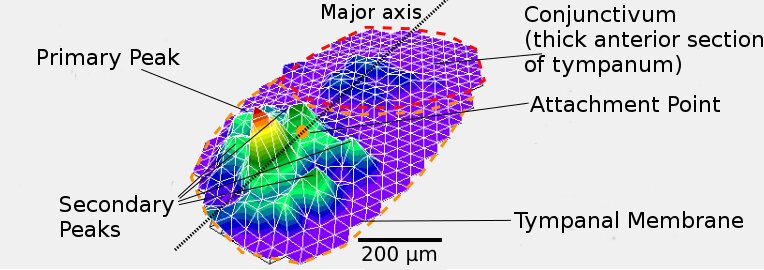Small but mighty: Insect-inspired microphones

What can an insect hear? Surprisingly, quite a lot. Though small and simple, their hearing systems are highly efficient. For example, with a membrane only 2 millimeters across, the desert locust can decompose frequencies comparable to human capability. By understanding how insects perceive sound and using 3D-printing technology to create custom materials, it is possible to develop miniature, bio-inspired microphones.
Andrew Reid of the University of Strathclyde in the U.K. presented his work creating such microphones, which can autonomously collect acoustic data with little power consumption.
His presentation, “Unnatural hearing—3D printing functional polymers as a path to bio-inspired microphone design,” took place Wednesday, May 10 as part of the 184th Meeting of the Acoustical Society of America.
“Insect ears are ideal templates for lowering energy and data transmission costs, reducing the size of the sensors, and removing data processing,” said Reid.
Reid’s team takes inspiration from insect ears in multiple ways. On the chemical and structural level, the researchers use 3D-printing technology to fabricate custom materials that mimic insect membranes. These synthetic membranes are highly sensitive and efficient acoustic sensors. Without 3D printing, traditional, silicon-based attempts at bio-inspired microphones lack the flexibility and customization required.
“In images, our microphone looks like any other microphone. The mechanical element is a simple diaphragm, perhaps in a slightly unusual ellipsoid or rectangular shape,” Reid said. “The interesting bits are happening on the microscale, with small variations in thickness and porosity, and on the nanoscale, with variations in material properties such as the compliance and density of the material.”
More than just the material, the entire data collection process is inspired by biological systems. Unlike traditional microphones that collect a range of information, these microphones are designed to detect a specific signal. This streamlined process is similar to how nerve endings detect and transmit signals. The specialization of the sensor enables it to quickly discern triggers without consuming a lot of energy or requiring supervision.
The bio-inspired sensors, with their small size, autonomous function, and low energy consumption, are ideal for applications that are hazardous or hard to reach, including locations embedded in a structure or within the human body.
Bio-inspired 3D-printing techniques can be applied to solve many other challenges, including working on blood-brain barrier organoids or ultrasound structural monitoring.
Citation:
Small but mighty: Insect-inspired microphones (2023, May 10)
retrieved 10 May 2023
from https://techxplore.com/news/2023-05-small-mighty-insect-inspired-microphones.html
This document is subject to copyright. Apart from any fair dealing for the purpose of private study or research, no
part may be reproduced without the written permission. The content is provided for information purposes only.
For all the latest Technology News Click Here
For the latest news and updates, follow us on Google News.

